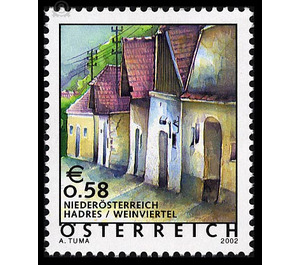Holiday Country Austria - Austria / II. Republic of Austria 2002 - 58 Euro Cent
Theme: Economy & Industry
| Country | Austria / II. Republic of Austria |
| Issue Date | 2002 |
| Face Value | 58.00 |
| Color | multi-colored |
| Printing Type | Photogravure |
| Stamp Type | Definitive |
| Item Type | Stamp |
| Chronological Issue Number | 1707 |
| Chronological Chapter | OOS-OE2 |
| SID | 117266 |
| In 74 Wishlists | |
What are the Heurigen for the Vienna area, which are for the Weinviertel and for other wine-growing areas such as Carnuntum in eastern Lower Austria and Breitenbrunn and Heiligenbrunn in Burgenland, the cellar lanes mostly created outside the towns. But there are also cellar rows with Heurigenbetrieb outdoors such as the Ahrenberger Heurigen Traismauer.Voraussetzungen for the installation of a cellar lane are of course the appropriate terrain, so at least a slope, and the soil condition, e.g. a loess area to create the often many kilometers long basements can. Ideally, there are then steep-walled sunken paths in which the entrances to the cellars, which look like the front fronts of small winegrower's houses, are located on the left and right. In the area of Hadres, in the Pulkautal, not far from the Czech border, one speaks of "Kellertriften" (Trift = originally grass field, then way to the cattle pasture). The 60 km long Pulkautaler Kellergassen cycle path connects the Triften and lets the guests get to know the special features of the valley. These include, in addition to a glass of wine, of course, down-to-earth delicacies in a cozy, hearty cellar snack. It's true what a Pulkautaler brochure says: "Kellertriften" are places where people live, celebrate and laugh. One almost forgets that the cellar lanes were actually created for pressing and storing the wines.


